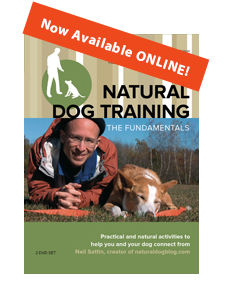Welcome to the 4th edition of the all about dog training blog carnival. I'm not sure how many more of these carnivals I'm going to host, so let me know if you're finding these useful, or if you'd just rather hear more Natural Dog Training info. After weeding out some obviously spamiferous submissions, I think I've whittled it down to the few bloggers who put some sincere effort into submitting something relevant. Much appreciated!
Eric Frey tells us about how to know if your dog is overweight. Learn the signs, and then, if your dog is overweight, do something about it!
P.L. Frederick has a few things to say about her dog's encounter with a skunk. The post contains a useful link to methods for removing skunk smell (I've had luck with the dish soap/hydrogen peroxide technique - although I would not use a dishwashing detergent - I'd just use some good ol' Dawn), and I love her Zen comment "Stink touch all" in relation to how smell might be just as effective a means for maintaining the world's equilibrium.
A note before you read the following two articles: Here on the Natural Dog Training blog, we have barely even discussed the notion of "corrections". I will be addressing that topic in the future, but suffice to say that I definitely don't use them the way that a dog trainer would traditionally use them. That all being said, I am including these submitted articles in the all about dog training blog carnival so that you can familiarize yourself with the "traditional" way of thinking about negative reinforcement - so in our future discussions you will be able to see the difference in the Natural Dog Training approach to "shocks".
At her Pet Expertise Dog Training blog, Jessica Rollins writes about how to reward good behavior and discourage bad behavior (in a dog) throughout your normal daily routine. She'll get you thinking about the positive behaviors your dog might be displaying that you weren't even conscious of, and gives you some tips on methods you might choose to "discourage" bad behaviors in your dog.
Finally, at the Dog Sport Network, Bob Levy writes an article entitled "Let's Bring Back the Old School" focusing on good ol' fashioned negative reinforcement.
Thanks again to all of the bloggers who participated in this edition of the All About Dog Training blog carnival. Stay tuned for information on overcoming separation anxiety, later this week here on the Natural Dog Training Blog. Are there other topics that you'd like to see addressed? Let me know.





Thanks for including my dog's skunk "tail" in your informative posting! I've added a couple links to this nifty site over at Small & Big.
"Corrections" and more importantly "shocks"(in terms of natural dog training) are something I've really been wanting to see a topic/discussion on. Since I began natural dog training, I haven't once found an actual need to administer any sort of "shock". The times I've tried it either have little to no effect at all, or injected more stress into my dog.
I've kind of wrestled with this idea back and forth. I respect Kevin Behan, you, and LCK(the three most brilliant trainers I know :P) immensely, but I really do wonder if leash shocks are ever actually -necessary- to the training process. It seems without them it may take a bit longer to get the desired effect/behavior, but if it means avoiding pain, I say it's worth it.
I understand the point and idea behind "shocks" in natural dog training speak, but it still bugs me pain is being used. Yes, I know it's not necessarily being interpreted by the dog as actual "bad pain" in most cases, but it's still pain nonetheless. It may be called an "energy-exchange system", or "shocking" the flow of drive, etc. etc., but the bottom line is, a leash correction is being performed on the dog. Pain is being administered to train.
I'm done yanking any sort of collar around my dog's neck, regardless of the drive state he's in. I guess personally, I've done many exercises in Kevin's book WITHOUT using the "shock" part-- and with mostly very good success.
Maybe I'm way off base here, but in my personal and albeit limited(in comparison) experience with this type of training-- I just have doubts about the actual necessity.
your carnival caught my eye as I posted to another carnival, just thought I'd stop by for a moment or two. Read through the entries, liked the one linking to Dog Sport Network so thanks for that.
what a great site! i apply my psychology skills to communicating with my dogs. your site will help other psych students to enhance the well being of their pets, and to apply their theories and models in the real world
P.L. - My pleasure, thanks for your participation!
Ben - I totally understand where you're coming from, man. Hopefully my upcoming article on how shocks are implemented in NDT will help you figure out whether it will ever be useful for you.
Annette - Glad you found a useful article - keep coming by 🙂
Charmayne - Thanks for the link back. I look forward to hearing more about how your psychology skills come to bear on dog training - especially because NDT can be rather unconventional at times.
To Ben,
I understand where you're coming from too.
I think the thing that makes the most sense to me is how Kevin described what I call the "chase me with hidden pops" game, which is a counter-conditioning exercise, to make the dog feel that hard pops on the collar are actually a good thing.
Basically he says that if you've got the dog's drive revved up, and he's chasing you full-bore, and you give him a good, hard pop on the collar he'll do one of two things: either he'll lose focus (his ears will go back, his shoulders get lower, he'll look away, etc.), or it'll make him even more driven to catch up with you; he'll be more energized.
So if you're doing the "chase me with hidden pops" and it DOESN'T make the dog more interested in chasing you, it DOESN'T keep him in the game, you've either popped him too hard, or you haven't built his drive or arousal to a high enough level.
The thing about pain is that it's kind of relative. I don't want this to sound like the old dominance thing of "A little pain is good for the dog! How else is he gonna learn?" What I'm saying is that at a certain level of arousal something that would ordinarily be experienced as pain can actually be quite bracing, even pleasurable. Whether it's Madonna telling the world she likes getting spanked during sex, or a lineman for the Chicago Bears saying he loves getting his first hard hit of the game, that he doesn't feel truly alive until someone from the other team tries to hit him as hard as they can, etc., there's a truth there. On a certain level pain and pleasure are interchangeable, or can be.
The other part of it is that you're right. You want to leave physical corrections as a last resort. They should only be used as the third step of the training process, which the way I see it goes like this:
STEP 1: Here's a game called "sit."
STEP 2: Here are the rules of the game.
STEP 3: The rules always apply.
(Sit is a bad example because it's not really critical that the rules should always apply the way it is with coming when called, instantly, no matter what else is going on.)
In the 1st step everything is positive. In the 2nd, if the dog doesn't sit perfectly (the way he would at an obedience trial, sitting directly in front of you with his head up, etc.), you simply don't reward him until he does it properly. In the 3rd step, the dog has to sit despite all kinds of distractions going on around him. The idea in using corrections there isn't to punish him for NOT sitting because he saw a squirrel, or wants to sniff another dog; it's to "shock" the dog's system so as to redirect his energy and focus back onto you.
(And like I said, this isn't critical with the sit the way it is with the recall.)
But you're right. If you can get there without corrections, you should go for it.
I can't wait to read Neil's explanation of this.
LCK